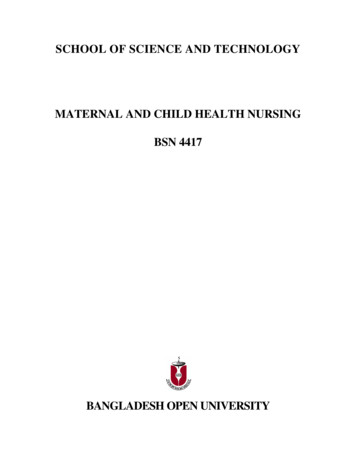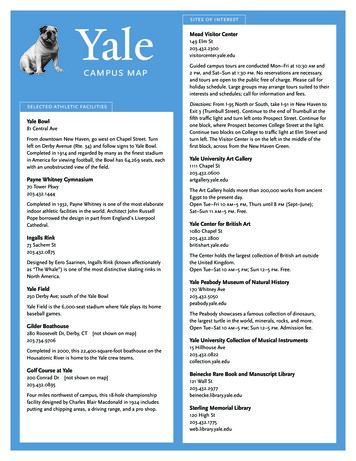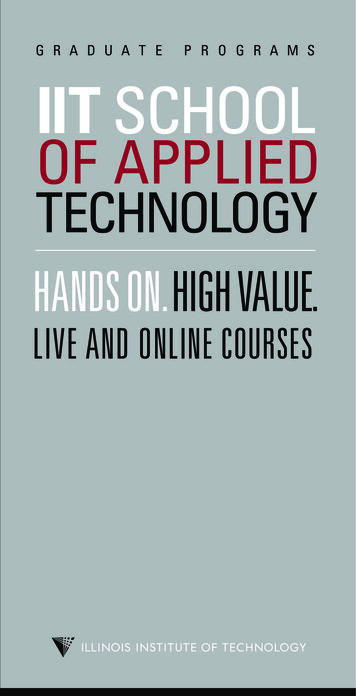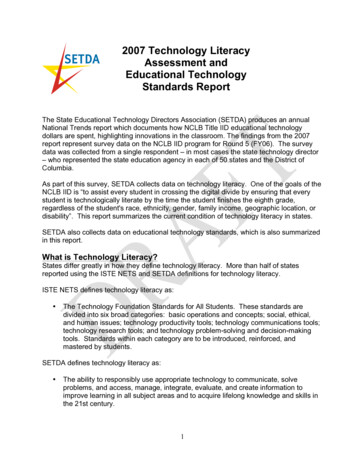
Transcription
SCHOOL OF SCIENCE AND TECHNOLOGYMATERNAL AND CHILD HEALTH NURSINGBSN 4417BANGLADESH OPEN UNIVERSITY
SCHOOL OF SCIENCE AND TECHNOLOGYMATERNAL AND CHILD HEALTH NURSINGBSN 4417Course Development TeamWritersDr. Farida Easmin ShelleyAssistant ProfessorProfessor Dr. Nurul HaqueBangladesh Medical College, DHAKAProf. Dr. L. Col. MostafaUttra Medical College, DhakaEditorRahima Jamal AkterCollege of NursingMohakhali, DhakaProgram Co-ordinatorDr. Farida Easmin ShelleyAssistant ProfessorSchool of Science and TechnologyBangladesh Open UniversityOver All SupervisionProfessor Khawja Jakaria Ahmad ChistyDeanSchool of Science and TechnologyBangladesh Open UniversityBANGLADESH OPEN UNIVERSITY
MATERNAL AND CHILD HEALTH NURSINGBSN 4417Published by:Publishing, Printing and Distribution DivisionBangladesh Open University, Gazipur-1705 School of Science and TechnologyBangladesh Open UniversityJuly 2005Computer Composed and DTP Layout by:Md. Jakir HossinCover Designed by:Md. Monirul IslamCover Graphics:Abdul MalckPrinted by:ISBN 984-34-4019-6All rights reserved. No Part of this book may be reproducedin any form without prior permission of the copyright holderSCHOOL OF SCIENCE AND TECHNOLOGYBANGLADESH OPEN UNIVERSITY
ContentsMaternal and Child Health NursingUnit 1: Basics of Maternal and Child HealthLesson 1Lesson 3Lesson 4: Importance of Maternal and Child Health, Safe Motherhood,Role of Midwife in Safe Motherhood Initiatives .: Global and National Picture on MMR and IMR. National MCHProgramme for Reduction of MMR and IMR .: MCH Services Delivery System in Bangladesh .: Impact of Women States and Education on Maternal Health .Unit 2: Review of Maternity CycleLesson 1: Review of Maternity Cycle–Pregnancy: Physical andPhysiological Changes in Pregnancy .: Care During Antenatal Period-Antenatal Assessment, Advices,Preparation for Labour and Delivery .: Intranatal Care Stage of Labour, Monitoring and Conduction ofLabour, Complication, Identification and Management .: Post-natal Care Immediate and Late Care of the Mother and theNewborn .: Post-natal Check-Up, Postnatal Complications and Management: Planning of Standard Maternity Unit / Hospital .: Preventive Measures: In promotion of Child Health, InfantFeeding, Immunization and Health Education .Lesson 2Lesson 2Lesson 3Lesson 4Lesson 5Lesson 6Lesson 7Unit 3: Child Health Nursing in BangladeshLesson 1Lesson 2Lesson 3Lesson 4Lesson 5:::::Unit 4: Common Child Health Problems in BangladeshLesson 1Lesson 2Lesson 3Lesson 4: Management of Fever in Children .: Diarrhoea .: Management of Low Birth Weight Neonates at Home .Management of Children with Malnutrition, Diarrhoea, ARI,Scabies, Worms, etc. .: Rickets and Osteomalacia .: Scurvy .: Vitamin A Deficiency And Xerophthalmia .Lesson 5Lesson 6Lesson 7Trends, Concepts, Facilities in Child Care .Organization of Child Health Services in Bangladesh (0-5 years)Growth and Development of Children (0-5 years) .Preventive Measures in Promotion on Child Health .Immunization .14101317232731343741455154576469778489949699
Lesson 8Lesson 9Lesson 10Lesson 11::::Short Notes on Other Vitamins .Important Minerals .Scabies and Worms .Management of Behavioural Problems and Mental Disturbancesin Children .102104106108
Maternal and Child Health NursingUnit 1: Basics of Maternal and Child HealthLesson 1: Importance of Maternal and ChildHealth, Safe Motherhood, Role ofMidwife in Safe Motherhood Initiatives1.1. Learning ObjectiveOn completion of this lesson you will be able to define maternal and child healthdescribe the importance of maternal and child healthdefine safe motherhood andexplain role of midwife in safe motherhood.1.2. Maternal and Child HealthMaternal and child health refers to the promotive, preventive, curative andrehabilitative health care of mothers and children up to preschool age. Itincludes maternal health, child health, family planning etc.1.3. Importance of Maternal and Child HealthMost developing countries in the world women in the childbearing ageand children under 15 constitute two-third (⅔rd) of whole population. InBangladesh, 48.5% of the total population of female and 46% of the totalfemale population is within the reproductive age (15-49 years).Maternal mortality rate is considered as one of the major indicator ofmaternal and child health service globally.From recent studies on maternal death (WHO and UNICEF), around6,00,000 maternal death occurs in each year globally and of them 99%occur in developing countries.In Bangladesh about 6,00,000 of the 4 million women become pregnantevery year and 10-15% women suffer from various delivery complicationssuch as fistulae, prolapse, pelvic inflammatory disease, hemorrhoidsperineal term, urinary incontinence etc.According to Bangladesh Demographic and Health Survey Report 1996to- 1997, 71% mothers do not receive antenatal care. Most of thedeliveries are conducted at home and conducted by untrained Dai.Bangladesh Open University1
Basics of Maternal and Child HealthFor the above reason, and for reduction of maternal, infant, prenatalmortality morbidity and promotion of reproductive health, MCH care isvery much important.1.4. Safe MotherhoodSafe motherhood means creating the circumstances within which a womanis enabled to choose whether she will become pregnant and if she does,ensuring that she Receives care for prevention and treatment of complication ofpregnancy, Has access to trained birth assistance, Has access to emergency obstetric care if she needs it, and care afterbirth.So that she can avoid death or disability from complications of pregnancyand childbirth.1.5. Role of Midwife in Safe Motherhood InitiativeIn safe motherhood programme, role of midwife is very much important.She can take very active part for success of safe motherhood programme.She provides various important activities, these are follows Antenatal Service – Midwifes visit pregnant women at least threetime during pregnancy. During these visits, they can identify the riskfactors of pregnancy and educate mothers on nutrition, personalhygiene and vaccination. Safe Delivery – Midwife conducts non-risk deliveries. Post Natal Care - Follow up of post natal mothers at home, referringthem to the nearly health centres for complication and motivatemothers for breast feeding. Immunization - Children are given BCG, DPT, OPV and measlesvaccine. Future mothers are given TT injection. Vitamin A Capsule Distribution - Vitamin A capsule is routinelydistributed to children twice a year to prevent night blindness. Distribution of ORS - ORS is distributed. Parents are taught toprepare ORS at home.School of Science and Technology2
Maternal and Child Health Nursing "Health Education - Education on general health, personal cleanliness, immunization, risk factors sexually transmitted diseases AIDsfamily planning, nutrition, breast-feeding, weaning food to children,and additional food to mothers.1.6.Exercise1.6.1. Multiple choice questionsTick ( ) the correct answer1.How many percentage mothers do not receive antenatal inBangladesh.a.b.c.d.7 0%71%72%73%.2.Vitamin A capsule should be given to childrena.b.c.d.Once a yearTwice a yearThree times a yearFour times a year.1.6.2. Short questions1.2.3.4.What is maternal and child health?What are importance of maternal and child health?What is safe motherhood?What are roles of midwife in safe motherhood?Bangladesh Open University3
Basics of Maternal and Child HealthLesson 2: Global and National Picture on MMRand IMR. National MCH Programme forReduction of MMR and IMR2.1. Learning ObjectivesOn completion of this lesson you will be able to define maternal deathdefine MMR and IMRdescribe causes of MMR and IMRtake preventive measures for MMR and IMR.2.2. Maternal DeathA maternal death is the death of women while pregnant, or within 42 daysof termination of pregnancy, irrespective of the duration and site of thepregnancy, from any cause related to or aggravated by the pregnancy or itsmanagement, but not from accidental or incidental causes.Source: Ninth Revision of International Classification of Diseases (ICE9), World Health Organization.2.3. MMR (Maternal Mortality Rate)The total number of death of women due to complications of pregnancy,childbirth, and within 42 days of delivery from ‘puerperal causes’ perthousands live birth, in an area during a calendar year.Total no. of femaledeath due to complications of pregnancy,childbirthor within 42 days of delivery from ' puerperalcauses'in an area during a calendar year.MMR 1000Total numberof live births in the same area and year.It is expressed as rate per 1000 live births.In western countries, MMR is less than 0.5.MMR in Bangladesh in estimated as 3.6 (1997) per 1000 live birth andtargeted to reduce to 3 with in 2002.School of Science and Technology4
Maternal and Child Health Nursing2.4. Causes of Maternal Death in BangladeshA. Obstetric Cause Toxaemia of pregnancy e.g. pre-eclamptic toxaemia (PET) andeclampsia. Hemorrhage – APH, PPH Infection Obstructed labour Septic abortion Puerperal sepsis Poor Antenatal care.B. Non-Obstetric Cause Severe anemia Cardiac, Hepatic, Renal Infections Malignances Accidents.C. Social factorEarly childbirth, parity, too closes pregnancy, malnutrition, poverty,Illiteracy Ignorance, lack of maternity services, poor environmentalsanitation poor communication and transport c21%11%causeFig.: Causes of maternal death in Bangladesh.Bangladesh Open University5
Basics of Maternal and Child Health2.5. IMR (Infant Mortality Rate)It is the ratio of infant deaths registered in a given year to the total numberof live births registered in the same year, usually expressed as a rate per1000 live births.IMR No of deaths in a year of children less than of age 1 year 1000No. of live births in the same yearIn Bangladesh IMR 57/ 1000 live birth (both sex).Male – 58/ 1000 live births.Female – 56/ 1000 live births.2.6. Causes of Infant MortalityMajor CauseA. Neonatal mortality (0-4 weeks) Prematurity Low birth weight Birth injury and asphyxia Congenital anomaly Hemolytic disease of the newborn Enteritis and other diarrhoeal disease.B. Post Natal Mortality Lower respiratory tract infection e.g. bronchitis and borne chittypneumonia. Gastrointestinal and diarrhoeal diseases. Communicable diseases- whopping cough, measless influenza,Chicken pox, diphtheria. Accidental injury. Malnutrition Congenital anomaly.School of Science and Technology6
Maternal and Child Health NursingMeaseles7%Others Causes24%Neonatal Tetanus8%Diarrhoa30%ARI18%Prematurity & LBW11%Whoping Cough2%Fig.: Causes of infant mortality in Bangladesh.2.7. National MCH Program for Reduction of MMR and IMRA. The main MCH problems in Bangladesh. Malnutrition Infection Uncontrolled reproduction.Measure to be taken to Solve these ProblemDirectFood supplementationIndirectImmunizationFood fortificationSafe water supplyFood enrichmentFamily planningDistribution of iron and folic acidHealth educationNutrition educationFood hygienePrimary health care (PHC)B. MCH Based Family PlanningMCH centres are located where mothers are attended for antenatal checkup delivery care and after deliver care. Their husbands and childrenaccompany them to the centre. During this period, they can be bettermotivated towards family planning.Family planning will be highly effective if based at MCH centres. Becausethese centres are attended by mothers before, during and after delivery.Bangladesh Open University7
Basics of Maternal and Child HealthMothers are directly exposed to the risks of childbirth, so family planningmotivation is more important for them.C. MCH Care within Essential Service Package (ESP)ESP is the most important health package of the population in both ruraland urban Bangladesh.It aims at safe pregnancy and delivery including fertility regulation;treatment of abortion and avoiding unwanted pregnancy. It also includeschild health care and reproductive health care.Programme area covered by ESP are as follows A. Child Health Care Control programme for diarrhocal disease, ARI, CDD Vaccinepreventable disease (EPI). For preventing malnutrition take extensive and intensive programme. Other preventive and curative care.B. Reproductive Health Care Prevention, control and treatment of RTI/ STD/ AIDS/ HIV. Care for safe pregnancy. Avoiding unwanted pregnancies. Menstrual regulation. Managing maternal and adolescent health. Involvement of female education complement and empowermentprogramme.C. Communicable disease control programme TB, Leprosy, Malaria, Kalaozar, STD, RTI, HIV, AHD etc. It provides information, education and communication. Improving the health of individuals and the nation.School of Science and Technology8
Maternal and Child Health Nursing"2.8.Exercise2.8.1. Multiple choice questionsTick ( ) the correct answer1.MMR per 1000 live birth in Bangladesh isa.b.c.d.33.23.43.6.2.The main MCH problems in d reproductionAll above.2.8.2. Short questions1.2.3.4.5.6.What is maternal death?How would you meansure MMR?What are causes of MMR in Bangladesh?What is IMR?What are causes of infant mortality?What are main problem of MCH program in Bangladesh? Howwould you overcome it?Bangladesh Open University9
Basics of Maternal and Child HealthLesson 3:MCH Services Delivery System inBangladesh3.1. Learning ObjectivesOn completion of this lesson you will be able to understand the aims of MCH servicesexplain the importance of MCH services anddescribe the MCH services in Bangladesh.3.2. The aims of an MCH service are as followA. Every expectant mothers maintains good health. Every expectantmothers be prepared physically and psychologically to look after herchild. Every expectant mothers goes through normal delivery. Everyexpectant mothers bears a healthy child.B. Every child grows up in healthy surroundings. Every child receivesproper nourishment. Every child receives adequate protection fromdiseases.C. Communicable diseases are controlled in the vulnerable groups bypreventive measures and health education.D. Early detection and treatment of illness in Children before they becomeserious or chronic.E. Maintenance of statistical data on morbidity and mortality.3.3. Importance of MCH Service1. The child bearing mothers 22.3% and under five children 15-20%entities more than 40% of total populations.2. 19% of total population is women (15-49 years).3. Mothers and children are more vulnerable or high-risk group.4. The maternal mortality and infant (under five Children) mortality ratein very high in developing countries. In Bangladesh MMR 3.0/ 1000live birth and IMR 57/ 100 live birth.5. By improving the health of mothers and children, we can improve thehealth of total population.School of Science and Technology10
Maternal and Child Health NursingFor these above reasons maternal and child health (MCH) services arevery important in Bangladesh.3.4. MCH Services in BangladeshGovernment and nongovernmental organization provide MCH care inBangladesh.The government organizations under the Ministry of Health and FamilyWelfare provide health and it has been also serving maternal and childhealth care at different levels Union, Thana, District and national levels.CIVIL SURGEONDISTRICTDDFPTHFPORMOTHANAMO sMO/ MCH/FPHI/SIAHIsTFPOSENIORMA sHAsFWNFPAUNIONTWASWARDTBAFig.: Organizational structure of MCH services in Bangladesh.At Community or Village Levela. Health assistant (HA) and family welfare assistant (FWA). Theydelivered health and family planning services. FWA distributescontraceptives and carry out motivational work for family planning.b. Traditional birth attendants and pallichickitshocks village doctors. Alarge number of TBA and pallichickitshocks work in the community.They provide perinatal care to pregnant women, attend deliveries athome and also provide postnatal care.Bangladesh Open University11
Basics of Maternal and Child HealthAt Union LevelOrganizational structure: Union is the first level of health facilities. Atthe union level, there are union sub-centre (USC) and family welfarecentre (FWC). The USC under the health division and FWC under thefamily planning division. Both are linked with thana health complex.At Upazila Level or Thana LevelEvery upazila or thana health complex comprise an MCH unit and providecare for pregnant women, under five children and family planningservices. Also responsible for motivation and data collection activities.At District LevelThere are two sets of facilitiesa. MCWC (Maternal and Child Welfare Centre) - Provides all essentialcare for pregnant women and under 5 children and family planningneeds for non-pregnant women.b. District General Hospital.MCH Service at the National Level"At the national level, all hospitals attached to medical colleges, providegynae, obstetric and pediatric services and the family planning modelclinic, provide contraceptives services.3.5.Exercise3.5.1. Short questions1.2.3.4.What is MCH care?Describe in brief MCH program in Bangladesh.Write down the aims and objective of MCH services.Why MCH services is important in our country.School of Science and Technology12
Maternal and Child Health NursingLesson 4:Impact of Women States and Educationon Maternal Health4.1. Learning ObjectivesOn completion of this lesson you will be able to importance of female education education can help to make a wise decision education can reduce MMR and IMMR.4.2. IntroductionFemale education is the key factor to improve the overall health andhygienic conditions of any country (Masud, 1999), The ‘World HealthOrganization’ (WHO) is one of the organs of United Nations Organizationhas stressed much for the primary care especially on women health.Female education would reduce the morbidity, infant mortality rate, crudebirth rate and crude death rate. It also increases the overall longevity andexpectancy of life. Most of the mothers in developing countries are notaware of nutrition. The health of the mother and foetus during pregancydepends mostly on nutrition. Female education can be help the people tomake a wise decision concerning their health, their family and the qualityof life at the community level.Healthy Mother and Healthy NationHealthy mother can deliver a healthy child. Birth weight of newborn babydoes not only indicate mother’s better health and nutrition, it also indicatesthe future health status of both mother and the child (Deller, 1995).Education on nutrition has a very strong effect on a maternal and childhealth. Women suffer more than men in case of iron deficiency anemia.There is a large gap of iron deficiency anemia in women and men that isof 458 million adult women and 238 million men (world developmentreport, 1993). Women’s nutritional problems are the worst in thedeveloping countries, where prevalence of anemia, protein-energymalnutrition and vitamin-A deficiency are the highest. Anemia andProtein-Energy Malnutrition (PEM) affects larger number of women andrequire more continuous intervention. In case of pregnancy and lactatingmother folic acid and vitamin-B, vitamin-C are the essential requirementfor the growth of foetus and newborn. People do not know that onlyregular supply of ferrous sulfate tablets can prevent or anemia amongpregnant and lactating women (Jamison, 1990).Bangladesh Open University13
Basics of Maternal and Child HealthWomen in developing countries suffer from a broad array of reproductivehealth problems, which have an adverse impact on their health, maritaland economic condition. In Bangladesh, 25% of the 3000 womensurveyed showed symptoms of pelvic tract infection and two thirds ofthese had clinical or laboratory evidence of an infection. The study furtherindicated that more than 50% of the female bad been suffering frommoderate to severe degree of malnourishment when more than 70% areilliterate (world development report, 1993). It is due to the lack of healtheducation that most of the female in developing countries face multipledisease like general weakness, malnutrition, anemia, sex and skin disease,peptic ulcer, tuberculosis, pelvic infection, respiratory tract infection etc.(Tomkins 1989). The female education includes-counseling aboutsexuality, contraception, abortion, infection in pelvic organ, pregnancy,iron deficiency anemia, malnutrition, importance of breast-feeding and itsadvantages etc.Due to the lack of sufficient knowledge of maintenance of female health,women who are the most vital part of any nation cannot contribute to thesociety though they have all the potentialities to serve the nation. Toreduce protein energy malnutrition some measures like more food availityto households production, employment opportunities for women,decreasing the time and energy cost of women’s home production shouldbe taken into consideration (ICDDRB, 2000). Poor health and nutritionreduce the gains of schooling in three areas, enrollment, ability to learnand participation by girls. Children who enjoy better health and nutritionduring early childhood are more likely to be ready to get enrolled in theschools earlier. It is clear that the factors like malnutrition, anaemia,infection etc. are the main causes of morbidity and mortality of motherand child. These cause can be romoved by proper female health education,thus female health education can contribute to enhance the overallcondition of the women folk of the under developed countries. Moreover,female health education changes behavior pattern of mother and helps topromote health, prevents illness, cures disease and facilitatesrehabilitation.World development report (1993), on female health and developmentexhibited the relationship between different income groups of people ofseveral countries. The result of the study has been shown in Table 1.The report indicates that female education is directly related with the childand maternal mortality. The table clearly shows that child and maternalmortality is directly related to the female education. In case of developingcountries like Ghana, Pakistan, India the rate of female education is lowerwhich causes greater child and maternal mortality. On the other hand, thedeveloped countries like Canada, USA, Germany have higher rate ofSchool of Science and Technology14
Maternal and Child Health Nursingfemale education and the rate of child and maternal mortality is muchlower than developing countries.Table Health, welfare of women of different countries of the worldHealth and WelfareUnder-5mortality rate(per 1,000 livebirths)FemaleMale19911991China and India96w104wOther low-income75w80wLow-income 37Sri-Lanka1925Middle-income gh income economiesCanada810United states913Germany810Life expectancy at birth 42534960515747596674Male1970 73Maternalmortality(per 0803726Table Health, education of women of different countries of the worldEducationPercentage of cohort persistingFemales per 100 malesto grade- 4FemaleMalePrimarySecondary19701986197 1986 197019901970 19900China and India78w65wOther low-income79w65wLow-income economies65w66w74w 105Middle-income 51Malaysia889569104Bangladesh Open University15
Basics of Maternal and Child HealthHigh income economiesCanadaUnited 9398Exercise4.3.1. Short questions1.2.3.What is importance of female education?How can education help of make a wise decision?How can education reduce MMR and IMMR?School of Science and Technology16
Maternal and Child Health NursingUnit 2: Review of Maternity CycleLesson 1: Review of Maternity Cycle –Pregnancy: Physical and PhysiologicalChanges in Pregnancy1.1. Learning ObjectivesOn completion of this lesson you will be able to know the maternity cyclerecognize the physical (anatomical) and physiological changes thata women undergoes during the cycletell in which stage of cycle a pregnant woman is.Maternity CycleThe stages in maternity cycle are 1. Fertilization2. Antenatal or prenatal period (pregnancy period)3. Intranatal period (delivery period)4. Post-natal period (period after delivery)5. Interconceptional period (period between delivery of baby toconception for next baby).PregnancyIt occurs when the liberated ripe ovum is fertilized by a spermatozom.Pregnancy is a physiological condition of a woman during herreproductive period (16-45 years) in which development of fertilizedovum occurs within the maternal body. Average duration of pregnancyis 40 weeks. Early pregnancy (1st to 12 weeks) 1st trimester Mid pregnancy (13th to 28th weeks) 2nd trimester Late Pregnancy (29th to 40 weeks) 3rd trimester.A. Physical Changes in PregnancyDuring pregnancy there is progressive and gradual physical changes inthe genital organ and all the systems of the body as the mother adaptsto the increasing demands of the foetus.Bangladesh Open University17
Review of Maternity Cyclea. UterusThe uterus grows enormously, give nourishment and protection to thegrowing, so increase in weight and size. The non-pregnant uterusmeasures 7.5 cm in length and weighing 50 gm, at term its weight 900– 1000 gm and length become 35 cm. Changes occurs in all three partsof the uterus – body, isthmus and cervix. The shape also changesseveral times. Non-pregnant uterus is pyriform, it becomes globular at12 wks. It is pyriform or oval by 28 weeks and again becomesspherical beyond 36th weeks.The uterus enlarges by muscle hypertrophy and limited hyperplasia, 6times more than normal. There is simultaneous increase of thesupporting fibrous and elastic tissues and the vascular system, arteries,venous and also lymphatic channels.Isthmus: Elongated 3 times and become softer. It begins to merge withthe uterine body after 12 weeks until it incorporated into the uterinecavity.b. Cervix Softening of the cervix as early as 6 weeks (Goodell’s sign). Thissoftening helps cervix during labour Hypertropy and Hyperplasia of elastic and connective tissue. Increased vascularity (so blue coloured) Hypertropy of gland and cervical canal.c. Vulva and Vagina Increased vascularity, soft, relaxed and blue coloured. Increased secretion (copious and tenacious due to effect ofprogesterone) giving rise to physiological leucorrhoea duringpregnancy. Acidic secretion due to more lactic acid generation.d. OvaryOestrogen and progesterone secreted from the corpus luteum maintainsthe environment for the growing ovum and its size increased (upto 3rdmonth maximum in 8th weeks) regresses when placenta is fully formed.e. Breast: Change in breast best seen in a primae gravide Increased size, vascularity increases with superficial dilated veins. Formation of primary and secondary areola Montgomery’s tubercle (Hypertrophied areola)School of Science and Technology18
Maternal and Child Health Nursing Consistency – more lobulated Striae graviderum over breast Secretion of colostrum starts after 12 weeksf. Abdominal Wall Muscles are streched and umbilicus is flattened out. Skin is stretched formation of striae gravidarum Pigmentation from pubis to umbilicus – lineanigrag. Pelvic Joints Softening and slight relaxatoin of ligaments of sacroiliac joint –due to release of hormone relaxin.h. General Change Pregnancy cloasma on cheek and forehead Pigmentation over nipples and external genitalia Linea nigra over abdomen – which after delivery becomes whitishmark called striae albicens. Striae gravidarum over abdomen and breast.B. Physiological Changes in Pregnancya. Weight gain and H2O Metabolism The total weight gain varies between 7 – 17 Kg (average 11 kg or24 lb)Weight gain – 1st trimester – 1 kg– 2nd trimester – 5 kgAveragerd– 3 trimester – 5 kg Retention of Na, K and Cl – due to increase oestrogen,progesterone and aldosteran, causes retention of H2O. Falling of wt or stationary of wt – suggestive of intra-uterinegrowth retradation or IU death, so weight should check regularly.b. Heart and Circulation Due to elevation of diaphragm the heart is pushed upward andoutwards with slight rotation to left. Cardiac output starts to increase from 10th week of pregnancyreaches peak at about 24-30 weeks and remain so till term. Cardiacoutput return to non-pregnant level by 6 weeks of post-partum.Bangladesh Open University19
Re
MATERNAL AND CHILD HEALTH NURSING BSN 4417 Course Development Team Writers Dr. Farida Easmin Shelley Assistant Professor Professor Dr. Nurul Haque Bangladesh Medical College, DHAKA Prof. Dr. L. Col. Mostafa Uttra Medical College, Dhaka Editor Rahima Jamal Akter College of Nursing Mohakhali, Dhaka Program Co-ordinator Dr. Farida Easmin Shelley











